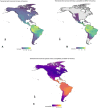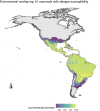American Mammals Susceptibility to Dengue According to Geographical, Environmental, and Phylogenetic Distances
- PMID: 33778034
- PMCID: PMC7987674
- DOI: 10.3389/fvets.2021.604560
American Mammals Susceptibility to Dengue According to Geographical, Environmental, and Phylogenetic Distances
Abstract
Many human emergent and re-emergent diseases have a sylvatic cycle. Yet, little effort has been put into discovering and modeling the wild mammal reservoirs of dengue (DENV), particularly in the Americas. Here, we show a species-level susceptibility prediction to dengue of wild mammals in the Americas as a function of the three most important biodiversity dimensions (ecological, geographical, and phylogenetic spaces), using machine learning protocols. Model predictions showed that different species of bats would be highly susceptible to DENV infections, where susceptibility mostly depended on phylogenetic relationships among hosts and their environmental requirement. Mammal species predicted as highly susceptible coincide with sets of species that have been reported infected in field studies, but it also suggests other species that have not been previously considered or that have been captured in low numbers. Also, the environment (i.e., the distance between the species' optima in bioclimatic dimensions) in combination with geographic and phylogenetic distance is highly relevant in predicting susceptibility to DENV in wild mammals. Our results agree with previous modeling efforts indicating that temperature is an important factor determining DENV transmission, and provide novel insights regarding other relevant factors and the importance of considering wild reservoirs. This modeling framework will aid in the identification of potential DENV reservoirs for future surveillance efforts.
Keywords: DENV 1-4; biotic interactions; machine learning; random forest; risk assessment; sylvatic cycle; wild reservoir.
Copyright © 2021 Robles-Fernández, Santiago-Alarcon and Lira-Noriega.
Conflict of interest statement
The authors declare that the research was conducted in the absence of any commercial or financial relationships that could be construed as a potential conflict of interest.
Figures







Similar articles
-
Current Knowledge and Ecological and Human Impact Variables Involved in the Distribution of the Dengue Virus by Bats in the Americas.Vector Borne Zoonotic Dis. 2021 Apr;21(4):217-231. doi: 10.1089/vbz.2020.2696. Epub 2021 Jan 13. Vector Borne Zoonotic Dis. 2021. PMID: 33439764
-
[Dengue virus infection in neotropical forest mammals: incidental hosts or potential reservoirs?].Med Trop (Mars). 2009 Aug;69(4):345-50. Med Trop (Mars). 2009. PMID: 19725384 French.
-
No Evidence of Dengue Virus Infections in Several Species of Bats Captured in Central and Southern Mexico.Zoonoses Public Health. 2016 Dec;63(8):579-583. doi: 10.1111/zph.12276. Epub 2016 Jun 30. Zoonoses Public Health. 2016. PMID: 27357156
-
Potential for Zika Virus to Establish a Sylvatic Transmission Cycle in the Americas.PLoS Negl Trop Dis. 2016 Dec 15;10(12):e0005055. doi: 10.1371/journal.pntd.0005055. eCollection 2016 Dec. PLoS Negl Trop Dis. 2016. PMID: 27977671 Free PMC article. Review.
-
The history and evolution of human dengue emergence.Adv Virus Res. 2008;72:1-76. doi: 10.1016/S0065-3527(08)00401-6. Adv Virus Res. 2008. PMID: 19081488 Review.
Cited by
-
Analysis of the Influence of Geographical Environment on Chinese Ethnic Folk Dance, Taking the Development of Dance Curriculum in Huaihua No. 1 Middle School as an Example.J Environ Public Health. 2022 Aug 29;2022:9692803. doi: 10.1155/2022/9692803. eCollection 2022. J Environ Public Health. 2022. Retraction in: J Environ Public Health. 2023 Sep 27;2023:9831640. doi: 10.1155/2023/9831640. PMID: 36072489 Free PMC article. Retracted.
-
Flavivirus Persistence in Wildlife Populations.Viruses. 2021 Oct 18;13(10):2099. doi: 10.3390/v13102099. Viruses. 2021. PMID: 34696529 Free PMC article. Review.
-
Predicting the dispersal and invasion dynamics of ambrosia beetles through demographic reconstruction and process-explicit modeling.Sci Rep. 2024 Mar 30;14(1):7561. doi: 10.1038/s41598-024-57590-1. Sci Rep. 2024. PMID: 38555364 Free PMC article.
-
Climate predictors and climate change projections for avian haemosporidian prevalence in Mexico.Parasitology. 2022 Jul;149(8):1129-1144. doi: 10.1017/S0031182022000683. Epub 2022 May 10. Parasitology. 2022. PMID: 35535473 Free PMC article.
-
Wildlife susceptibility to infectious diseases at global scales.Proc Natl Acad Sci U S A. 2022 Aug 30;119(35):e2122851119. doi: 10.1073/pnas.2122851119. Epub 2022 Aug 22. Proc Natl Acad Sci U S A. 2022. PMID: 35994656 Free PMC article.
References
LinkOut - more resources
Full Text Sources
Other Literature Sources

